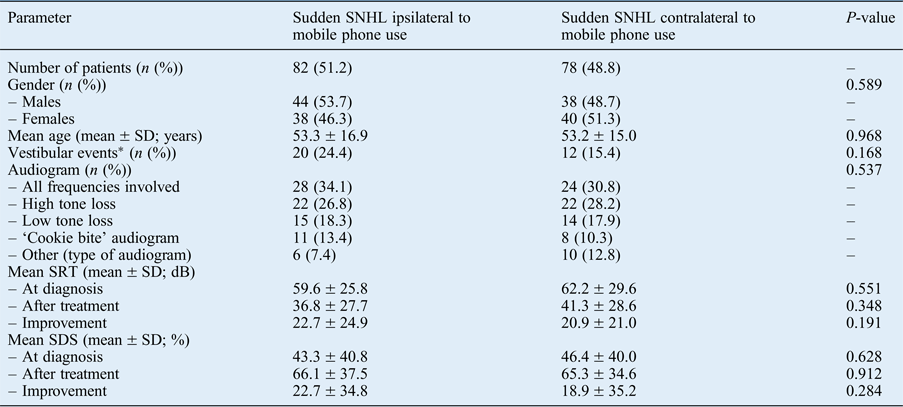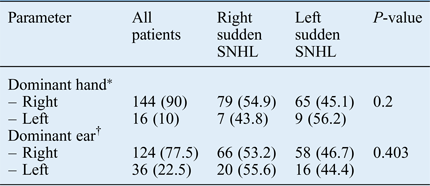Introduction
Mobile phone use has increased rapidly, with almost 6.9 billion subscribed mobile phone users in 2014. 1 Consequently, there has been increasing concern regarding the potential hazardous effect of exposure to the electromagnetic radiation emitted from these devices. The biological effect of the electromagnetic radiation emitted by mobile phones includes a small rise in tissue temperature of adjacent organs, an alternation in the permeability of the blood brain barrier and increased levels of oxidative stress.Reference Benson, Pirie, Schüz, Reeves, Beral and Greem 2 – Reference Hardell, Carlberg, Söderqvist and Mild 5 A significant positive correlation between exposure to radiation and the incidence of vestibular schwannoma was demonstrated in few studies while contradicted in others.Reference Benson, Pirie, Schüz, Reeves, Beral and Greem 2 , Reference Hardell, Carlberg, Söderqvist and Mild 5 , Reference Alexiou and Sioka 6 Though conflicting evidence exists, it has been suggested that these radiofrequency fields should be classified as a ‘probable’ human carcinogen.Reference Morgan, Miller, Sasco and Davis 7
No interaction between mobile phone usage and auditory function was demonstrated when testing several audiological parameters.Reference Sudan, Kheifets, Arah and Olsen 8 – Reference Velayutham, Govindasamy, Raman, Prepageran and Ng 11 However, a few recent studies did find that mobile phone users had a significantly greater risk of having elevated thresholds in the speech frequenciesReference Panda, Modi, Munjal and Virk 9 or high frequencies (above 8 kHz),Reference Panda, Jain, Bakshi and Munjal 10 , Reference Velayutham, Govindasamy, Raman, Prepageran and Ng 11 and absent distortion product otoacoustic emissions.Reference Panda, Modi, Munjal and Virk 9 , Reference Panda, Jain, Bakshi and Munjal 10
Sudden sensorineural hearing loss (SNHL) usually presents in an acute manner, mostly unilaterally, and can be accompanied by tinnitus, ear fullness or vertigo. The estimated annual incidence is 5–20 per 100,000, and this symptom is probably underdiagnosed.Reference Stachler, Chandrasekhar, Archer, Rosenfeld, Schwartz and Barrs 12 , Reference Weiss, Böcker, Koopmann, Savvas, Borowski and Rudack 13 Sudden SNHL is usually idiopathic, and less than one-third of all cases are attributed to haemorheological disturbances, viral infections and autoimmunological mechanisms.Reference Chau, Lin, Atashband, Irvine and Westerberg 14
Taking into account the literature correlating biochemical changes and neural damage,Reference Benson, Pirie, Schüz, Reeves, Beral and Greem 2 – Reference Hardell, Carlberg, Söderqvist and Mild 5 SNHL and long-term mobile phone usage,Reference Panda, Modi, Munjal and Virk 9 – Reference Velayutham, Govindasamy, Raman, Prepageran and Ng 11 and patients’ reports upon admission, we hypothesised that sudden SNHL might be somehow influenced or even triggered by mobile phone usage. We aimed to investigate, for the first time, the correlation between the laterality of sudden SNHL, handedness and the ear preferred for mobile phone use.
Materials and methods
The study included all patients who presented with first-time sudden SNHL in the out-patient clinic or the emergency room of the Department of Otolaryngology – Head and Neck Surgery in the tertiary referral Sheba Medical Center between March 2014 and September 2016. Sudden SNHL was defined as a unilateral SNHL that developed within 3 days, verified by 30 dB or higher elevation of the bone conduction threshold in three consecutive frequencies (compared to a previous audiology test or to the better hearing ear). Demographic data, personal medical history, treatment and audiology test results were retrospectively retrieved from the patients’ charts.
Patients were asked upon presentation in our hospital whether they use their mobile phone on a daily basis (the exact duration of usage per day was not quantified), what their dominant ear was (for mobile phone usage) and what their dominant hand was (for writing). All patients were referred to magnetic resonance imaging.
Exclusion criteria included: patients aged less than 18 years, previous history of sudden SNHL, previous otological surgery, final diagnosis of Ménière's disease, vestibular schwannoma or autoimmune inner-ear disease, and patients who reported that they hardly or never use a mobile phone.
The correlation between handedness, the dominant ear for mobile phone use and sudden SNHL laterality was investigated. Treatment protocols were out of the focus of the current study. The present study was approved by the Sheba Medical Center Institutional Review Board.
Statistical analysis
The mean and standard deviation of each measurement were determined. The student t-test and the chi-square test were applied to compare demographic, clinical and audiometric test results.
Results
The study included 178 patients with first-time sudden SNHL. Fourteen patients (7.9 per cent) were excluded because of Ménière's disease and autoimmune inner-ear disease, and four patients (2.2 per cent) were excluded because of vestibular schwannoma. Of the 160 patients with a final diagnosis of first-time sudden SNHL, 82 patients (51.3 per cent) were male and the mean age was 53.2 years (range, 19–84 years).
At presentation, the severity of the sudden SNHL was, in order of prevalence: moderate (n = 44; 27.5 per cent), severe (n = 43; 26.9 per cent), profound (n = 34; 21.25 per cent), moderate-to-severe (n = 29; 18.1 per cent) and mild (n = 10; 6.25 per cent). The mean speech reception threshold and speech discrimination score were 60.8 ± 27.7 dB and 45 ± 40.3 per cent, respectively (Table I). The audiogram curve was: flat (all frequencies involved) in 52 cases (32.5 per cent), down-sloping (involving high tones) in 44 cases (27.5 per cent), up-sloping (involving low tones) in 29 cases (18.1 per cent) and U-shaped in 19 cases (11.9 per cent); 16 cases (10 per cent) had other types of audiogram.
Table I Comparison between patients with sudden snhl in ear ipsilateral versus contralateral to side of mobile phone use

*Patients who described any complaints of true vertigo in the course of the current disease. SNHL = sensorineural hearing loss; SD = standard deviation; SRT = speech reception threshold; SDS = speech discrimination score
No correlation was found between the dominant hand or dominant ear and the side in which the sudden SNHL presented (Table II). In addition, there was no correlation between the side of the sudden SNHL (whether on the dominant or non-dominant side) and audiometric test parameters before or after treatment (level of hearing loss, speech reception threshold, speech discrimination score and the morphological feature of the pure tone threshold), nor with the clinical course of the disease (Table I).
Table II Hand, ear and sudden snhl laterality

Data represent numbers (and percentages) of patients, unless indicated otherwise. *Defined by the hand used for writing. †Defined by the ear preferred for mobile phone use. SNHL = sensorineural hearing loss
Discussion
A large corpus of evidence supports the hazardous potential of electromagnetic radiation emitted by mobile phones on brain tissue and neurons, including apoptosis induced by the increased level of oxidative stress biomarkers.Reference Benson, Pirie, Schüz, Reeves, Beral and Greem 2 – Reference Motawi, Darwish, Moustafa and Labib 4 However, to the best of our knowledge, our study showed for the first time that mobile phone usage does not affect sudden SNHL.
-
• Mobile phone use has increased rapidly, with almost 6.9 billion subscribed mobile phone users in 2014
-
• Some studies, but not others, have shown a positive correlation between vestibular schwannoma and radiation exposure
-
• In some recent studies, mobile phone users had greater risk of elevated thresholds in speech frequencies and absent distortion product otoacoustic emissions
-
• This is the first study to examine the correlation between mobile phone usage and sudden sensorineural hearing loss (SNHL)
-
• The cohort comprised 160 patients who experienced sudden SNHL for the first time
-
• Sudden SNHL laterality was independent of the laterality of the ear preferred for mobile phone use
Lateralisation of the auditory system is described as an asymmetry found in different levels of the auditory pathway that is already evident in newborns. In normal listeners, right ear preponderance is usually described based on auditory brainstem response measurements, otoacoustic emissions, responses to speech stimuli and different speech perception test results, whereas the left ear is supposed to be superior in non-verbal sound presentation (including brief melodies) and intonation discrimination.Reference Ari-Even, Hildesheimer, Roziner and Henkin 15 , Reference Migirov and Wolf 16 For the purpose of the current study, we defined the dominant ear as the ear that is usually preferred for mobile phone use.
Though exposure to radiation from mobile phones is highest in the temporal lobe, ipsilateral to the side of phone usage,Reference Hardell, Carlberg, Söderqvist and Mild 5 we found that the side of sudden SNHL was almost equally divided between right (53.75 per cent; n = 86) and left (46.25 per cent; n = 74). No correlation was found between the laterality of the ear preferred for mobile phone use or between the dominant hand (known to affect the preferred earReference Migirov and Wolf 16 ) and the side of sudden SNHL (Table II).
To conclude, this large cohort of 160 consecutive cases of first-time sudden SNHL demonstrates for the first time that there is no significant correlation between mobile phone usage and sudden SNHL. Future investigations should model the characteristics of common mobile phones and type of radiation involved, the amount of exposure and its latency in the patient population.




